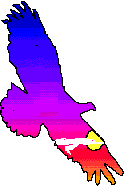

|
Aadizookaan -- means (in Anishinaabemowin, or Ojibwe language) "a traditional story", what anthros and others seem to like calling legends or myths. These are -- or in their original, were -- often sacred. Those represnt large themes of human existence: where we came from, how we should live, reconcilliation to the tragedies of life, thankfulness There are smaller stories: teaching, humorous, answering "Why?" questions about natural phenomena and behavior. Finally, traditional indigenous peoples had no TV, no books; stories were entertainment, too.
TO THOSE WHO TRANSCRIBE NATIVE MYTHS: Our myths appear popular as NuAge web page fillers. Native myths, as opposed to tall tales and little stories for children, are not entertainment. It is important that you cite the source from which you transcribed it, the collector or non-Indian reteller-translator of the myth, and if given, the original teller. And, of course, the tribe. I think Native myths are meaningless removed from cultural context, but if there is any educational value to them, they must be identified with a specific people, time, and place. Some retellers are reliable. Others sanitize and restructure stories, making them worthless as a means to learn about a culture -- a kind of racism, where retellers believe Native myths (which are often owned by specific individuals or families) are merely primitive raw material for their own literary efforts, often crude and condescending. There are cultural property (individual, tribal, cultural patrimony) and religious issues involved as well. Link is to a new web page discussing those issues. For most myths linked-to below, I have usually had to make such identifications as my small personal library will provide. I'm no expert, so if anyone from those tribes has more info, I'd be glad to get it. |
|---|

|
OUTSTANDING SPECIAL EDUCATIONAL INTEREST
|
|---|
Navigation Buttons
Page |
Menu |
MENU |
|---|
| Southeastern Tribes |
Plains Tribes |
Woodland Tribes |
California Indians |
|---|---|---|---|
| Northwest Coast, Inuit |
Southwest Tribes |
Unidentifiable Tribes and Related Material |
|
Page prepared by Paula Giese graphics and layout copyright 1995, 1996
Last updated: 1/11/97
 Page Navigation Buttons
Page Navigation Buttons